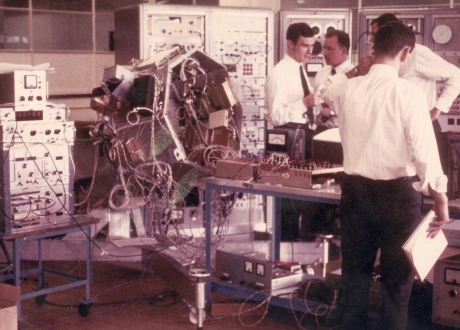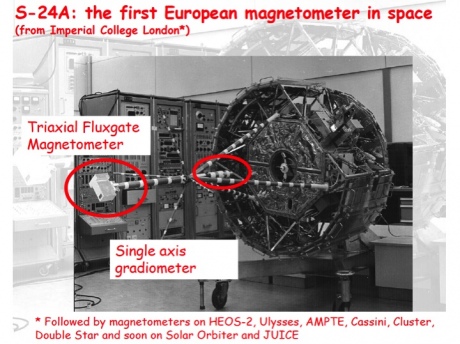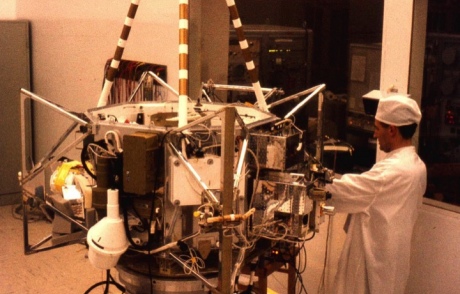

HEOS-1: First European spacecraft to reach interplanetary space - with almost half the scientific experiments provided by Imperial College London.
The early success in space research by Imperial College researchers was commemorated in the European Space Research and Technology Centre in Holland, on the occasion of the 45th anniversary of the launch of HEOS-1, the first European satellite to reach interplanetary space. The Space Physics group at Imperial College London has the longest continuous heritage in experimental space physics in Europe.

The assembly of the prototype of HEOS-1 in 1966 (Prof. Balogh is on the left).
On 5 December 1968, the European Space Research Organisation's HEOS-1 satellite was launched into its highly elliptical orbit around the Earth (hence its name). It was the first European satellite to venture into interplanetary space. What was also remarkable about this satellite is that three of the seven experiments it carried into space had been built by the Cosmic Ray Group in the Physics Department of Imperial College London, the predecessor of the current Space and Atmospheric Physics Group. This success for the Group came shortly after the launch, in May 1968, of the very first European satellite, ESRO-2 which also carried three experiments built and led by the Group, again out of the seven experiments in the payload. So on these first European satellites, six of the fourteen scientific investigations were led by members of the Imperial College Group - no other research group in Europe could boast of the such a successful start to their career in space!
On 20 November 2013, the HEOS-1 space mission was commemorated in a Symposium held in the European Space Research and Technology Centre (ESTEC) in Noordwijk, The Netherlands. The Symposium reunited about twenty of the engineers and scientists who had worked on the HEOS spacecraft. They were joined by the current Director of Science and Robotic Exploration, Prof. Alvaro Giménez and Dr Franco Ongaro, Director of Technical and Quality Management of the European Space Agency (ESA) and other senior staff of the Agency. In the Symposium, different aspects of the HEOS mission were presented, followed by reviews of current scientific programme of the Agency and its activities for developing new technologies and techniques, looking forward to the next decades of scientific space projects.

The scientific objectives and achievements of the HEOS mission were presented by Prof. André Balogh (Imperial College) who was one of the original experimenters on satellite. He presented the seven experiments in the payload and gave examples of their scientific results. The main objective of the mission was to make measurements of energetic particles associated with solar flares and their effects in the near-Earth space environment. Numerous scientific papers were published on this topic by the Imperial College investigators and their collaborators. In today's language, these results were highly relevant to understanding "space weather", a term not yet invented at the time, but already identified as highly relevant to the fast-growing space activities even at the time. One of the Imperial College experiments on HEOS-1 was the magnetometer, under the leadership of Peter Hedgecock, which yielded the largest number of scientific results from the mission; together with the Italian instrument on board that measured the solar wind, the magnetic field observations led to one of the first detailed mappings of the boundaries of the magnetosphere, the Earth's magnetic bubble that protects us from some of the worst effects of solar outbursts. Prof. Balogh concluded by enumerating the long and distinguished line of magnetic field investigations on world-leading space missions since the days of HEOS-1 to the present and the future, such as the Solar Orbiter and JUICE (JUpiter ICy moons Explorer). This anniversary is a good opportunity to celebrate the many decades of success of the Imperial College Space Physics team in scientific space research.

Installing the magnetometer experiment in the Junkers assembly and test facilities in Munich (Peter Hedgecock)
Article text (excluding photos or graphics) available under an Attribution-NonCommercial-ShareAlike Creative Commons license.
Photos and graphics subject to third party copyright used with permission or © Imperial College London.
Reporter
Professor Andre Balogh
Department of Physics

Contact details
Email: a.balogh@imperial.ac.uk
Show all stories by this author



